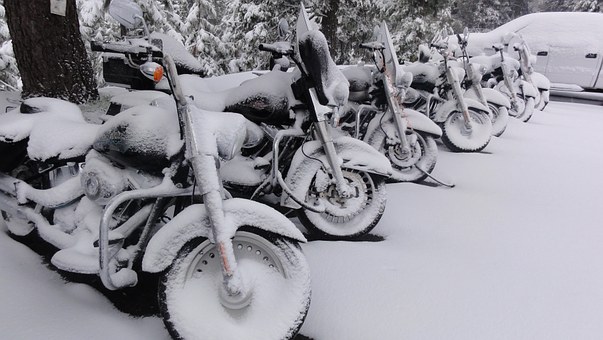With the weather turning cooler and winter upon us. FUN Motorcycle Training “LLC” we want everyone to think about storing their motorcycle for the winter. How to store and winterize your motorcycle for the cold months
For any number of reasons a lot of us park our motorcycles for the winter and there’s nothing wrong with that. The majority of us ride because it’s fun and in my experience riding through the winter isn’t especially entertaining. On the other hand, strolling into your garage on the first nice day of spring, primed and ready for that first ride only to find that your bike is upset at being ignored for the past three or four months and refuses to share your enthusiasm, is not entertaining either. What follows are a few tips to make sure that your bike enjoys it’s long winter nap and awakens refreshed and ready to roll.
Prepping for Winter
Start by giving the bike a good wash and wax. The object here is to remove any road grime or dirt that might trap water and cause corrosion and to protect the finish. Extra time spent detailing your bike now will pay big dividends over the cold dark winter. This is especially important if the bike will stored in non-climate controlled area. Give all the rubber parts a wipe down with Armor All or some other silicone based rubber preservative, and make sure you polish any aluminum to forestall corrosion.
Once the bucket work is finished add the recommended amount of Fuel Preservative, Stabil, Star-tron and Sea-Foam are three that come highly recommended. Next, take the bike for a short ride to the nearest gas station and top off the tank. This does three things, it’ll dry out all the nooks and crannies and warm up the oil, which will shortly be changing, and it’ll get the fuel additive flowing through the carburetors or injectors. A full fuel tank will also prevent corrosion caused by condensation from forming in the tank, but because the majority of fuel tanks now come with internal coatings, this doesn’t seem to be as large a problem as it once was.
Back home drain the oil and change the Oil Filter. If the bike uses a separate Oil supply for the transmission, you need to drain that as well, along with the rear end if you’re riding a shaft driven bike. Refill with the proper viscosity and amount of oil and you’ve made a major step towards a good start to the next riding season.
If your bike has carburetors and a petcock, turn the petcock off and let the engine idle until it stalls. The object here is to circulate the fresh oil, throughout the engine so that all of the engines internal parts spend their off time bathed in clean fresh oil, rather than the old contaminated stuff. As importantly it’ll also drain the float bowls and prevent the gasoline from turning into a festering pool of jet plugging varnish over the winter. If the bike has EFI or doesn’t use a petcock as some older bikes do, run the engine and let it idle for three minutes or so, then shut it off.
A word to the wise here, an air cooled engine should never be left to idle for more than five minutes, especially on a warm day. If for some reason you want to idle the engine for an extended period use a large house fan to blow air across the engine. By that same token if you’d rather not run your carburetor equipped bike out of fuel, you can simply drain the float bowls by removing the drain plug, which has the added advantage of letting any water or dirt drain out with it. Use an appropriate container to catch the drained fuel and be particularly careful if the engine’s still warm.
Park the bike where you want it to sit, preferably in an area where the temperature remains constant and out of the direct sunlight. If possible the bike should be stored with the tires clear of the ground, though that isn’t a strict necessity. Reduce the tire pressure by 10%. If you’re going to store the bike with the battery in place check and clean the terminals as needed, and if you’re using an old fashioned flooded cell “wet” battery top off the cells with distilled water, then connect the battery to a Battery Charger or “smart” charger. If the battery is being removed for storage you can service it at your leisure, but don’t forget that even a battery stored in a warm dry place, during my bachelor days I kept them in my hall closet over the winter, will still require periodic charging.
For the most part that’s it until spring, at which point you should be able to simply air up your tires, blow off the dust and hit the road. I will point out that winter is the perfect time to do all those little repairs, upgrades and maintenance jobs that you didn’t get around to during summer. In fact, while it’s by no means a requirement I generally perform a major service on my bike before putting it away and spread it out over a couple of weekends. It’s a relaxing way to pass the time and it ensures the bike will be in perfect condition come first grass
FUN Motorcycle Training “LLC” We hope these tips are helpful. Remember you want to be able to enjoy that first ride come Spring!!

